Understanding Business and Economic Environment Question 2022
VerifiedAdded on 2022/10/14
|14
|2651
|17
AI Summary
Contribute Materials
Your contribution can guide someone’s learning journey. Share your
documents today.
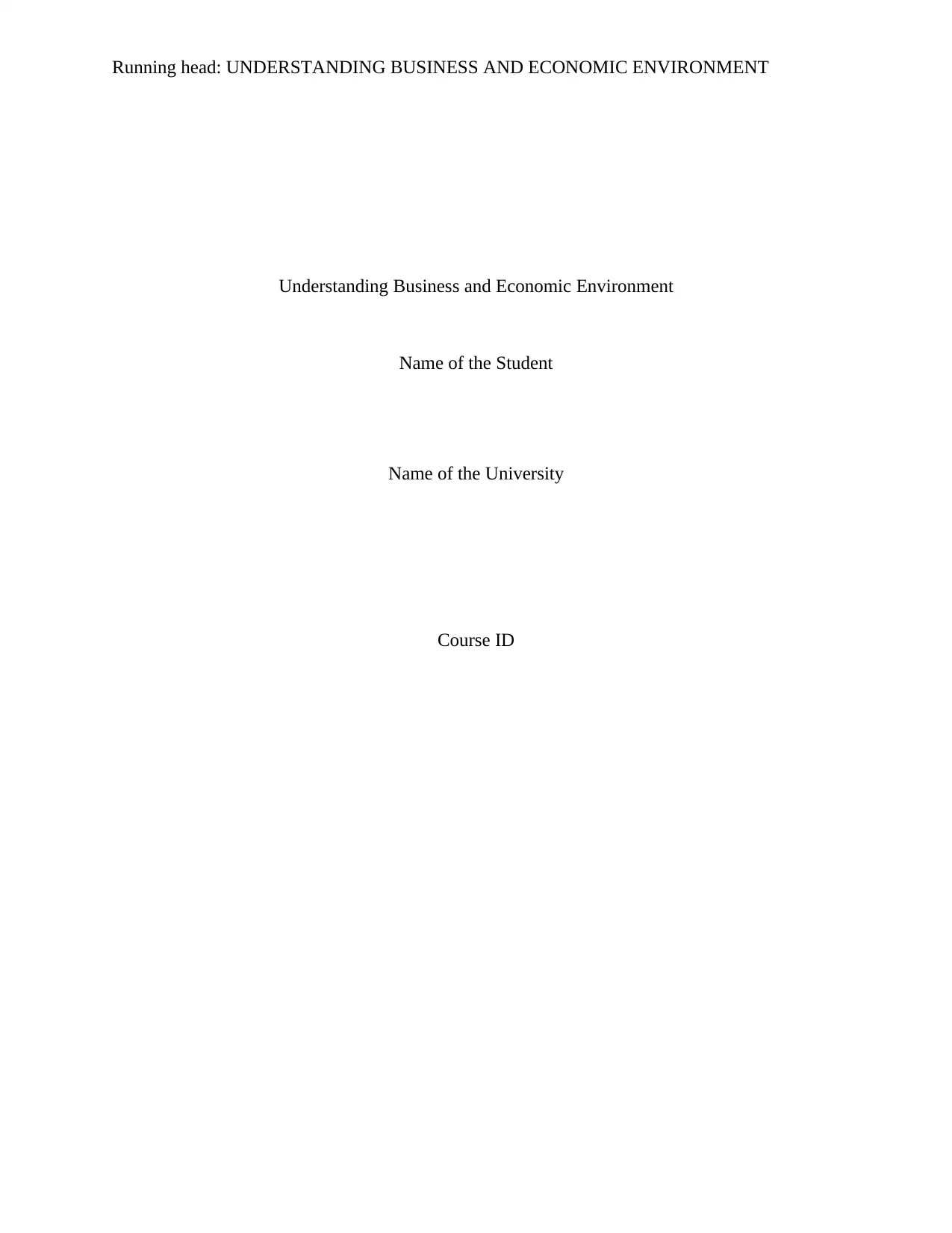
Running head: UNDERSTANDING BUSINESS AND ECONOMIC ENVIRONMENT
Understanding Business and Economic Environment
Name of the Student
Name of the University
Course ID
Understanding Business and Economic Environment
Name of the Student
Name of the University
Course ID
Secure Best Marks with AI Grader
Need help grading? Try our AI Grader for instant feedback on your assignments.
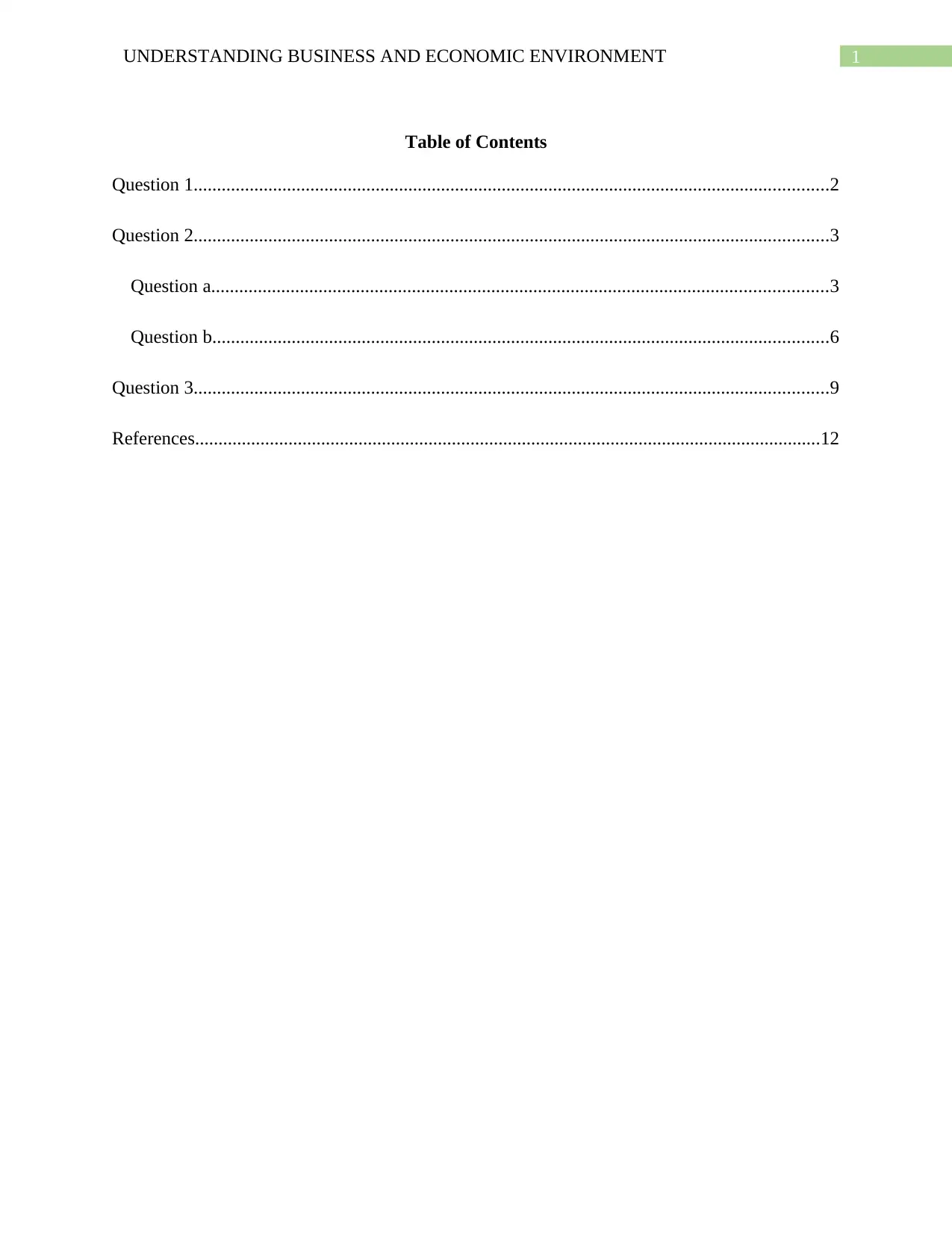
1UNDERSTANDING BUSINESS AND ECONOMIC ENVIRONMENT
Table of Contents
Question 1........................................................................................................................................2
Question 2........................................................................................................................................3
Question a....................................................................................................................................3
Question b....................................................................................................................................6
Question 3........................................................................................................................................9
References......................................................................................................................................12
Table of Contents
Question 1........................................................................................................................................2
Question 2........................................................................................................................................3
Question a....................................................................................................................................3
Question b....................................................................................................................................6
Question 3........................................................................................................................................9
References......................................................................................................................................12
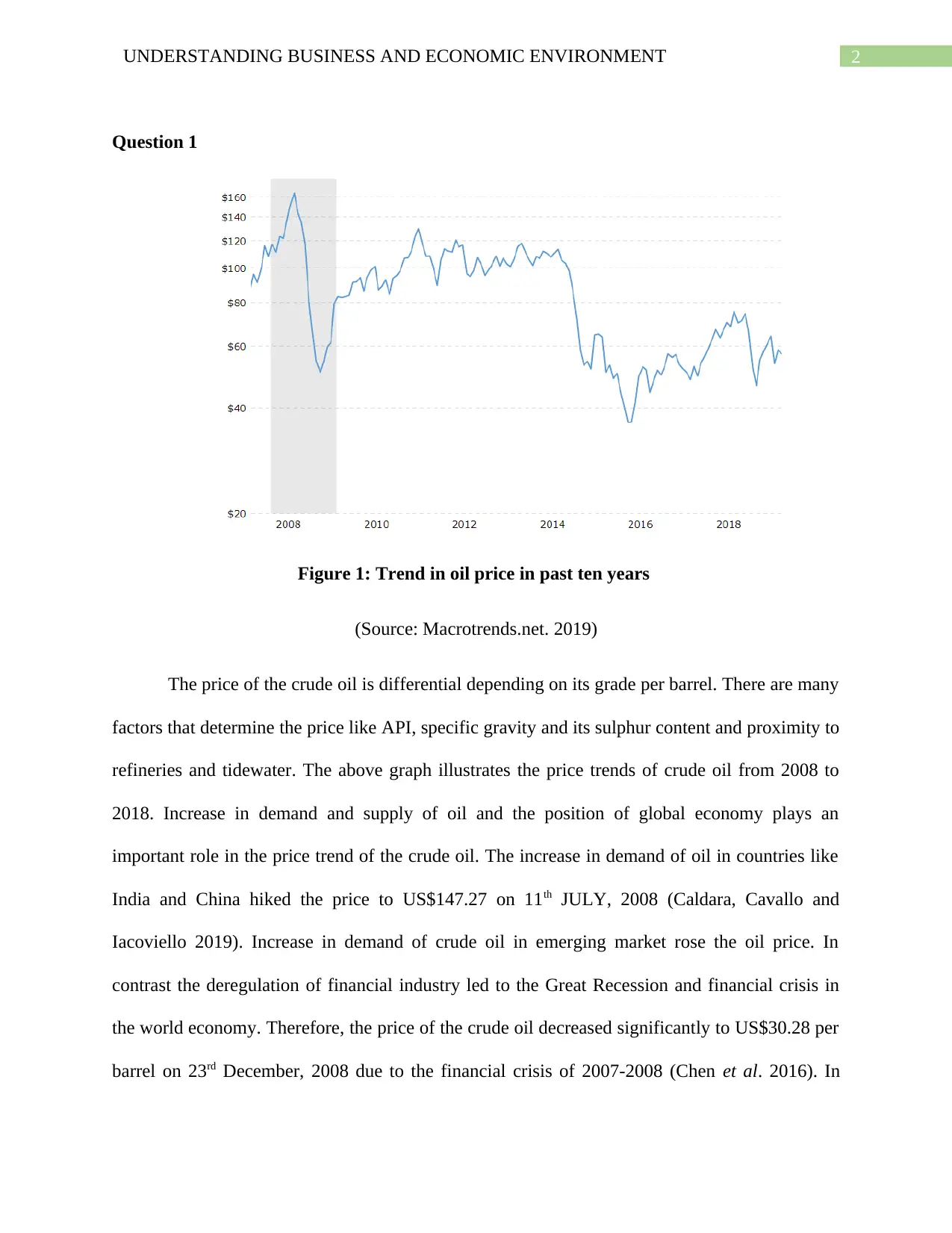
2UNDERSTANDING BUSINESS AND ECONOMIC ENVIRONMENT
Question 1
Figure 1: Trend in oil price in past ten years
(Source: Macrotrends.net. 2019)
The price of the crude oil is differential depending on its grade per barrel. There are many
factors that determine the price like API, specific gravity and its sulphur content and proximity to
refineries and tidewater. The above graph illustrates the price trends of crude oil from 2008 to
2018. Increase in demand and supply of oil and the position of global economy plays an
important role in the price trend of the crude oil. The increase in demand of oil in countries like
India and China hiked the price to US$147.27 on 11th JULY, 2008 (Caldara, Cavallo and
Iacoviello 2019). Increase in demand of crude oil in emerging market rose the oil price. In
contrast the deregulation of financial industry led to the Great Recession and financial crisis in
the world economy. Therefore, the price of the crude oil decreased significantly to US$30.28 per
barrel on 23rd December, 2008 due to the financial crisis of 2007-2008 (Chen et al. 2016). In
Question 1
Figure 1: Trend in oil price in past ten years
(Source: Macrotrends.net. 2019)
The price of the crude oil is differential depending on its grade per barrel. There are many
factors that determine the price like API, specific gravity and its sulphur content and proximity to
refineries and tidewater. The above graph illustrates the price trends of crude oil from 2008 to
2018. Increase in demand and supply of oil and the position of global economy plays an
important role in the price trend of the crude oil. The increase in demand of oil in countries like
India and China hiked the price to US$147.27 on 11th JULY, 2008 (Caldara, Cavallo and
Iacoviello 2019). Increase in demand of crude oil in emerging market rose the oil price. In
contrast the deregulation of financial industry led to the Great Recession and financial crisis in
the world economy. Therefore, the price of the crude oil decreased significantly to US$30.28 per
barrel on 23rd December, 2008 due to the financial crisis of 2007-2008 (Chen et al. 2016). In
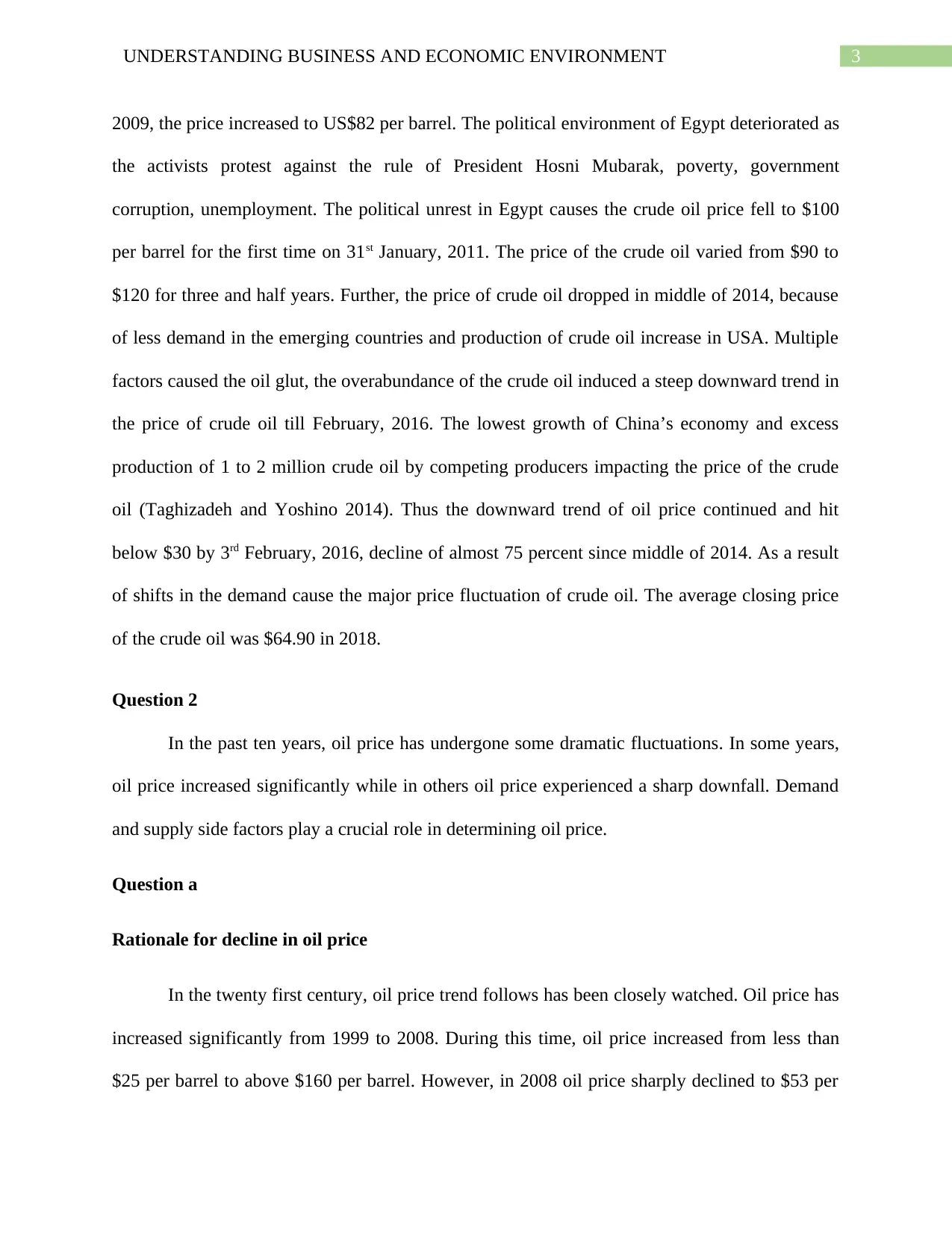
3UNDERSTANDING BUSINESS AND ECONOMIC ENVIRONMENT
2009, the price increased to US$82 per barrel. The political environment of Egypt deteriorated as
the activists protest against the rule of President Hosni Mubarak, poverty, government
corruption, unemployment. The political unrest in Egypt causes the crude oil price fell to $100
per barrel for the first time on 31st January, 2011. The price of the crude oil varied from $90 to
$120 for three and half years. Further, the price of crude oil dropped in middle of 2014, because
of less demand in the emerging countries and production of crude oil increase in USA. Multiple
factors caused the oil glut, the overabundance of the crude oil induced a steep downward trend in
the price of crude oil till February, 2016. The lowest growth of China’s economy and excess
production of 1 to 2 million crude oil by competing producers impacting the price of the crude
oil (Taghizadeh and Yoshino 2014). Thus the downward trend of oil price continued and hit
below $30 by 3rd February, 2016, decline of almost 75 percent since middle of 2014. As a result
of shifts in the demand cause the major price fluctuation of crude oil. The average closing price
of the crude oil was $64.90 in 2018.
Question 2
In the past ten years, oil price has undergone some dramatic fluctuations. In some years,
oil price increased significantly while in others oil price experienced a sharp downfall. Demand
and supply side factors play a crucial role in determining oil price.
Question a
Rationale for decline in oil price
In the twenty first century, oil price trend follows has been closely watched. Oil price has
increased significantly from 1999 to 2008. During this time, oil price increased from less than
$25 per barrel to above $160 per barrel. However, in 2008 oil price sharply declined to $53 per
2009, the price increased to US$82 per barrel. The political environment of Egypt deteriorated as
the activists protest against the rule of President Hosni Mubarak, poverty, government
corruption, unemployment. The political unrest in Egypt causes the crude oil price fell to $100
per barrel for the first time on 31st January, 2011. The price of the crude oil varied from $90 to
$120 for three and half years. Further, the price of crude oil dropped in middle of 2014, because
of less demand in the emerging countries and production of crude oil increase in USA. Multiple
factors caused the oil glut, the overabundance of the crude oil induced a steep downward trend in
the price of crude oil till February, 2016. The lowest growth of China’s economy and excess
production of 1 to 2 million crude oil by competing producers impacting the price of the crude
oil (Taghizadeh and Yoshino 2014). Thus the downward trend of oil price continued and hit
below $30 by 3rd February, 2016, decline of almost 75 percent since middle of 2014. As a result
of shifts in the demand cause the major price fluctuation of crude oil. The average closing price
of the crude oil was $64.90 in 2018.
Question 2
In the past ten years, oil price has undergone some dramatic fluctuations. In some years,
oil price increased significantly while in others oil price experienced a sharp downfall. Demand
and supply side factors play a crucial role in determining oil price.
Question a
Rationale for decline in oil price
In the twenty first century, oil price trend follows has been closely watched. Oil price has
increased significantly from 1999 to 2008. During this time, oil price increased from less than
$25 per barrel to above $160 per barrel. However, in 2008 oil price sharply declined to $53 per
Secure Best Marks with AI Grader
Need help grading? Try our AI Grader for instant feedback on your assignments.
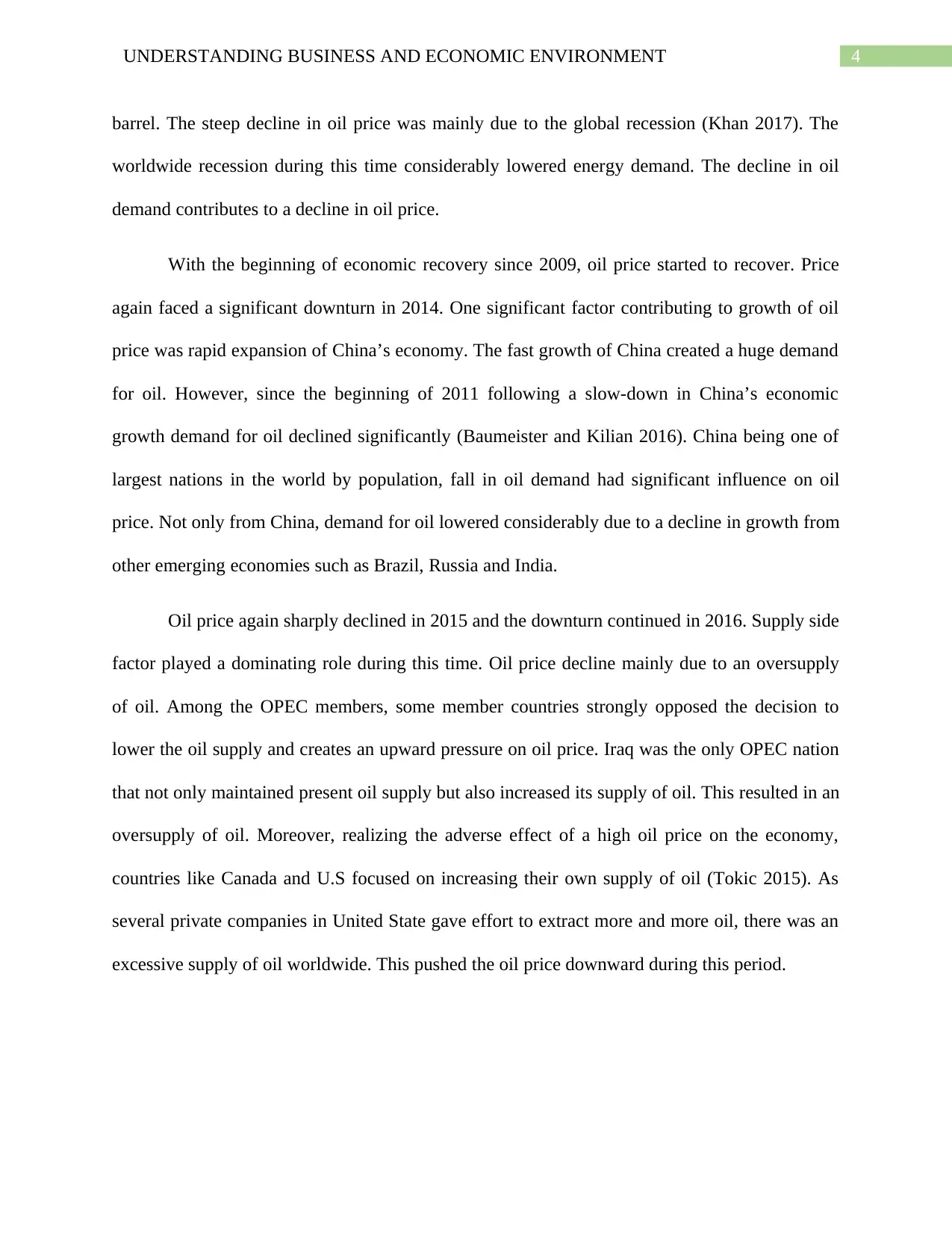
4UNDERSTANDING BUSINESS AND ECONOMIC ENVIRONMENT
barrel. The steep decline in oil price was mainly due to the global recession (Khan 2017). The
worldwide recession during this time considerably lowered energy demand. The decline in oil
demand contributes to a decline in oil price.
With the beginning of economic recovery since 2009, oil price started to recover. Price
again faced a significant downturn in 2014. One significant factor contributing to growth of oil
price was rapid expansion of China’s economy. The fast growth of China created a huge demand
for oil. However, since the beginning of 2011 following a slow-down in China’s economic
growth demand for oil declined significantly (Baumeister and Kilian 2016). China being one of
largest nations in the world by population, fall in oil demand had significant influence on oil
price. Not only from China, demand for oil lowered considerably due to a decline in growth from
other emerging economies such as Brazil, Russia and India.
Oil price again sharply declined in 2015 and the downturn continued in 2016. Supply side
factor played a dominating role during this time. Oil price decline mainly due to an oversupply
of oil. Among the OPEC members, some member countries strongly opposed the decision to
lower the oil supply and creates an upward pressure on oil price. Iraq was the only OPEC nation
that not only maintained present oil supply but also increased its supply of oil. This resulted in an
oversupply of oil. Moreover, realizing the adverse effect of a high oil price on the economy,
countries like Canada and U.S focused on increasing their own supply of oil (Tokic 2015). As
several private companies in United State gave effort to extract more and more oil, there was an
excessive supply of oil worldwide. This pushed the oil price downward during this period.
barrel. The steep decline in oil price was mainly due to the global recession (Khan 2017). The
worldwide recession during this time considerably lowered energy demand. The decline in oil
demand contributes to a decline in oil price.
With the beginning of economic recovery since 2009, oil price started to recover. Price
again faced a significant downturn in 2014. One significant factor contributing to growth of oil
price was rapid expansion of China’s economy. The fast growth of China created a huge demand
for oil. However, since the beginning of 2011 following a slow-down in China’s economic
growth demand for oil declined significantly (Baumeister and Kilian 2016). China being one of
largest nations in the world by population, fall in oil demand had significant influence on oil
price. Not only from China, demand for oil lowered considerably due to a decline in growth from
other emerging economies such as Brazil, Russia and India.
Oil price again sharply declined in 2015 and the downturn continued in 2016. Supply side
factor played a dominating role during this time. Oil price decline mainly due to an oversupply
of oil. Among the OPEC members, some member countries strongly opposed the decision to
lower the oil supply and creates an upward pressure on oil price. Iraq was the only OPEC nation
that not only maintained present oil supply but also increased its supply of oil. This resulted in an
oversupply of oil. Moreover, realizing the adverse effect of a high oil price on the economy,
countries like Canada and U.S focused on increasing their own supply of oil (Tokic 2015). As
several private companies in United State gave effort to extract more and more oil, there was an
excessive supply of oil worldwide. This pushed the oil price downward during this period.
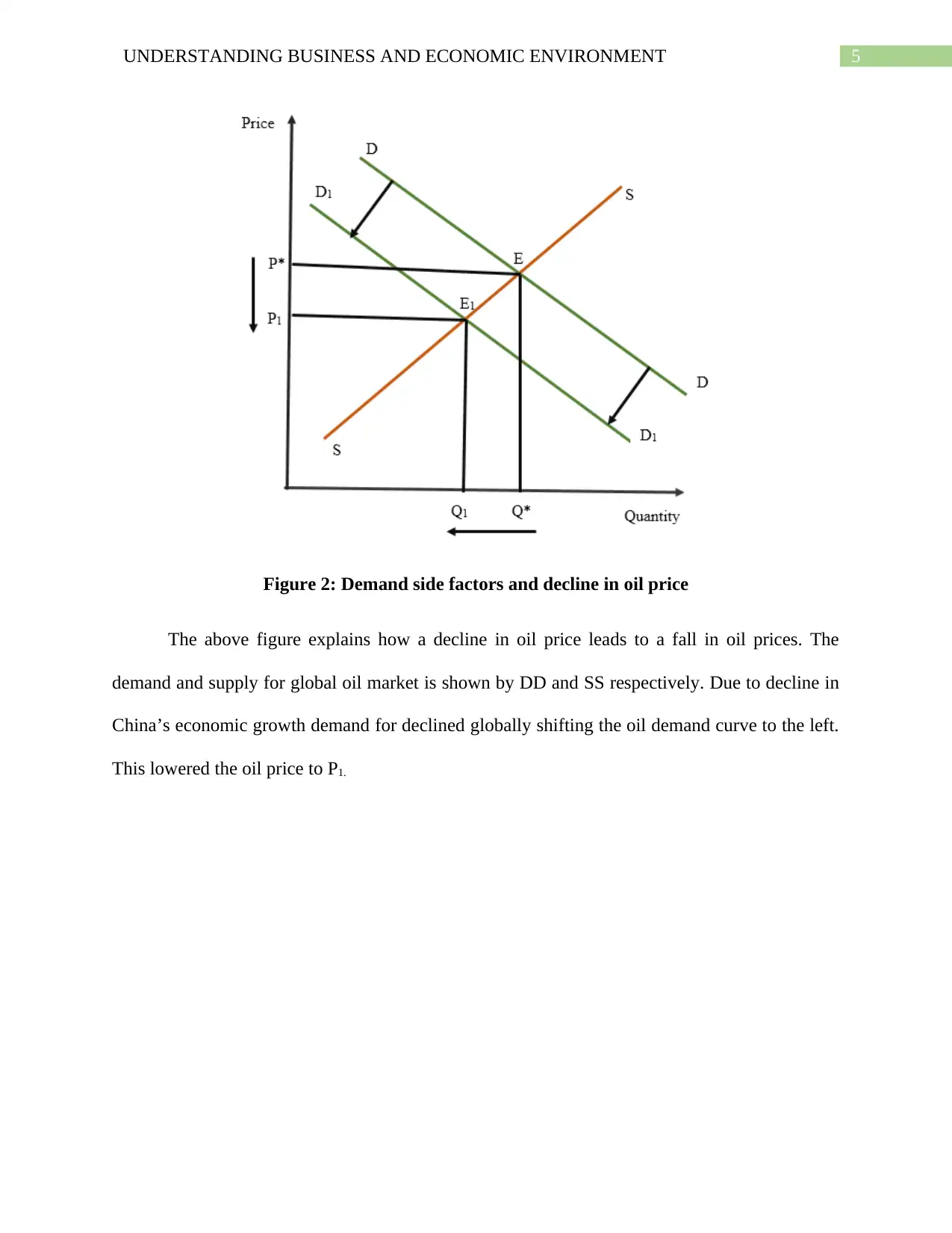
5UNDERSTANDING BUSINESS AND ECONOMIC ENVIRONMENT
Figure 2: Demand side factors and decline in oil price
The above figure explains how a decline in oil price leads to a fall in oil prices. The
demand and supply for global oil market is shown by DD and SS respectively. Due to decline in
China’s economic growth demand for declined globally shifting the oil demand curve to the left.
This lowered the oil price to P1.
Figure 2: Demand side factors and decline in oil price
The above figure explains how a decline in oil price leads to a fall in oil prices. The
demand and supply for global oil market is shown by DD and SS respectively. Due to decline in
China’s economic growth demand for declined globally shifting the oil demand curve to the left.
This lowered the oil price to P1.
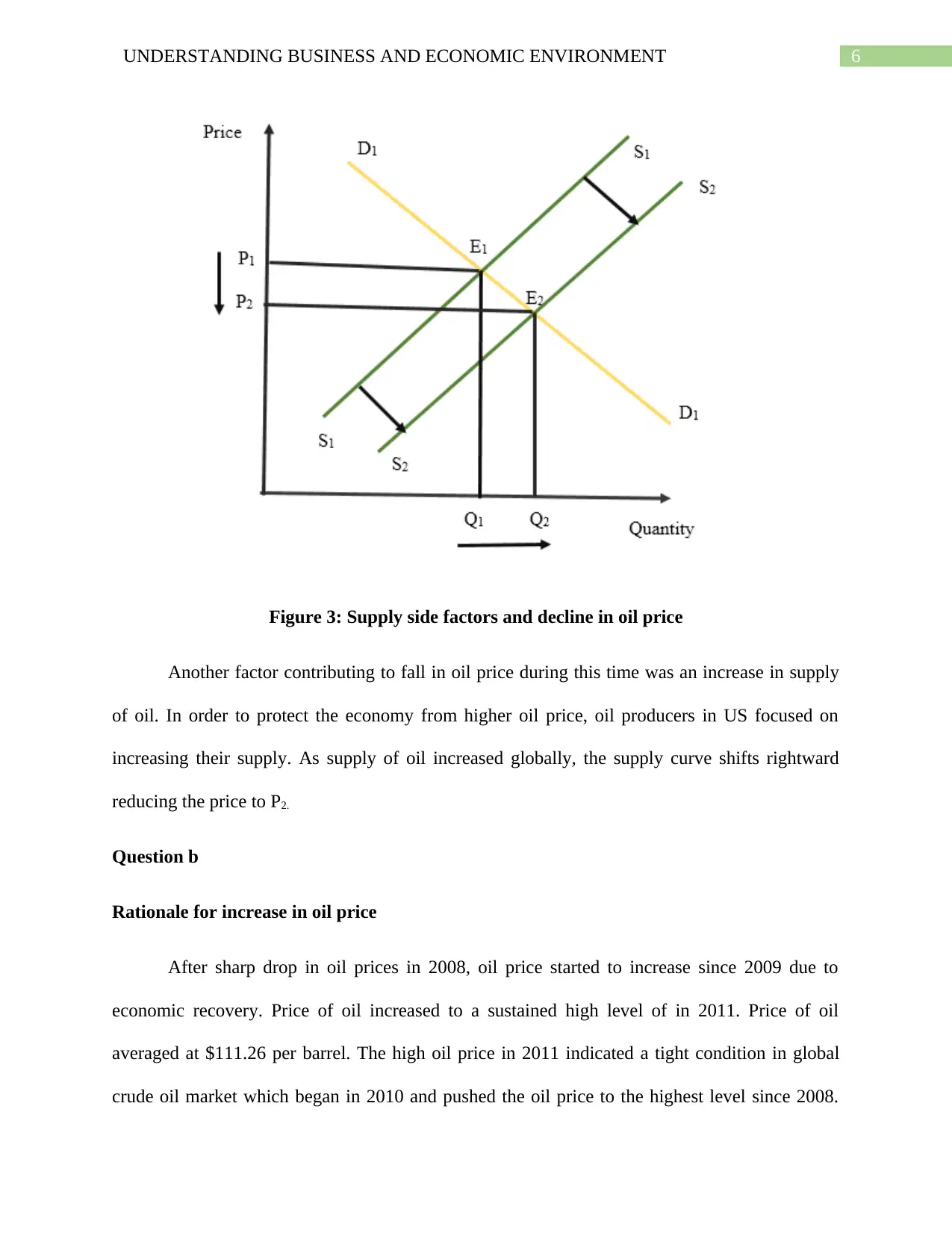
6UNDERSTANDING BUSINESS AND ECONOMIC ENVIRONMENT
Figure 3: Supply side factors and decline in oil price
Another factor contributing to fall in oil price during this time was an increase in supply
of oil. In order to protect the economy from higher oil price, oil producers in US focused on
increasing their supply. As supply of oil increased globally, the supply curve shifts rightward
reducing the price to P2.
Question b
Rationale for increase in oil price
After sharp drop in oil prices in 2008, oil price started to increase since 2009 due to
economic recovery. Price of oil increased to a sustained high level of in 2011. Price of oil
averaged at $111.26 per barrel. The high oil price in 2011 indicated a tight condition in global
crude oil market which began in 2010 and pushed the oil price to the highest level since 2008.
Figure 3: Supply side factors and decline in oil price
Another factor contributing to fall in oil price during this time was an increase in supply
of oil. In order to protect the economy from higher oil price, oil producers in US focused on
increasing their supply. As supply of oil increased globally, the supply curve shifts rightward
reducing the price to P2.
Question b
Rationale for increase in oil price
After sharp drop in oil prices in 2008, oil price started to increase since 2009 due to
economic recovery. Price of oil increased to a sustained high level of in 2011. Price of oil
averaged at $111.26 per barrel. The high oil price in 2011 indicated a tight condition in global
crude oil market which began in 2010 and pushed the oil price to the highest level since 2008.
Paraphrase This Document
Need a fresh take? Get an instant paraphrase of this document with our AI Paraphraser
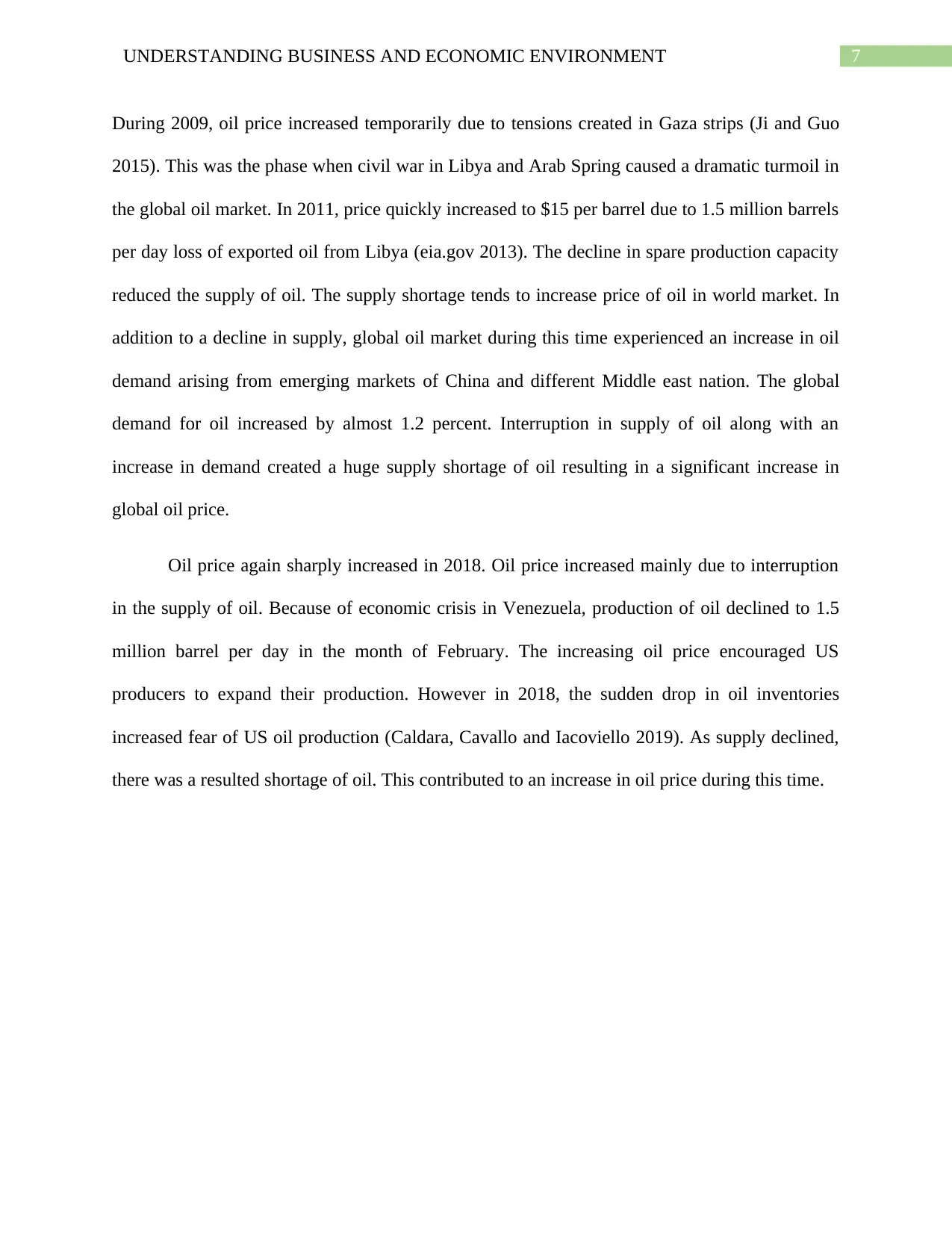
7UNDERSTANDING BUSINESS AND ECONOMIC ENVIRONMENT
During 2009, oil price increased temporarily due to tensions created in Gaza strips (Ji and Guo
2015). This was the phase when civil war in Libya and Arab Spring caused a dramatic turmoil in
the global oil market. In 2011, price quickly increased to $15 per barrel due to 1.5 million barrels
per day loss of exported oil from Libya (eia.gov 2013). The decline in spare production capacity
reduced the supply of oil. The supply shortage tends to increase price of oil in world market. In
addition to a decline in supply, global oil market during this time experienced an increase in oil
demand arising from emerging markets of China and different Middle east nation. The global
demand for oil increased by almost 1.2 percent. Interruption in supply of oil along with an
increase in demand created a huge supply shortage of oil resulting in a significant increase in
global oil price.
Oil price again sharply increased in 2018. Oil price increased mainly due to interruption
in the supply of oil. Because of economic crisis in Venezuela, production of oil declined to 1.5
million barrel per day in the month of February. The increasing oil price encouraged US
producers to expand their production. However in 2018, the sudden drop in oil inventories
increased fear of US oil production (Caldara, Cavallo and Iacoviello 2019). As supply declined,
there was a resulted shortage of oil. This contributed to an increase in oil price during this time.
During 2009, oil price increased temporarily due to tensions created in Gaza strips (Ji and Guo
2015). This was the phase when civil war in Libya and Arab Spring caused a dramatic turmoil in
the global oil market. In 2011, price quickly increased to $15 per barrel due to 1.5 million barrels
per day loss of exported oil from Libya (eia.gov 2013). The decline in spare production capacity
reduced the supply of oil. The supply shortage tends to increase price of oil in world market. In
addition to a decline in supply, global oil market during this time experienced an increase in oil
demand arising from emerging markets of China and different Middle east nation. The global
demand for oil increased by almost 1.2 percent. Interruption in supply of oil along with an
increase in demand created a huge supply shortage of oil resulting in a significant increase in
global oil price.
Oil price again sharply increased in 2018. Oil price increased mainly due to interruption
in the supply of oil. Because of economic crisis in Venezuela, production of oil declined to 1.5
million barrel per day in the month of February. The increasing oil price encouraged US
producers to expand their production. However in 2018, the sudden drop in oil inventories
increased fear of US oil production (Caldara, Cavallo and Iacoviello 2019). As supply declined,
there was a resulted shortage of oil. This contributed to an increase in oil price during this time.
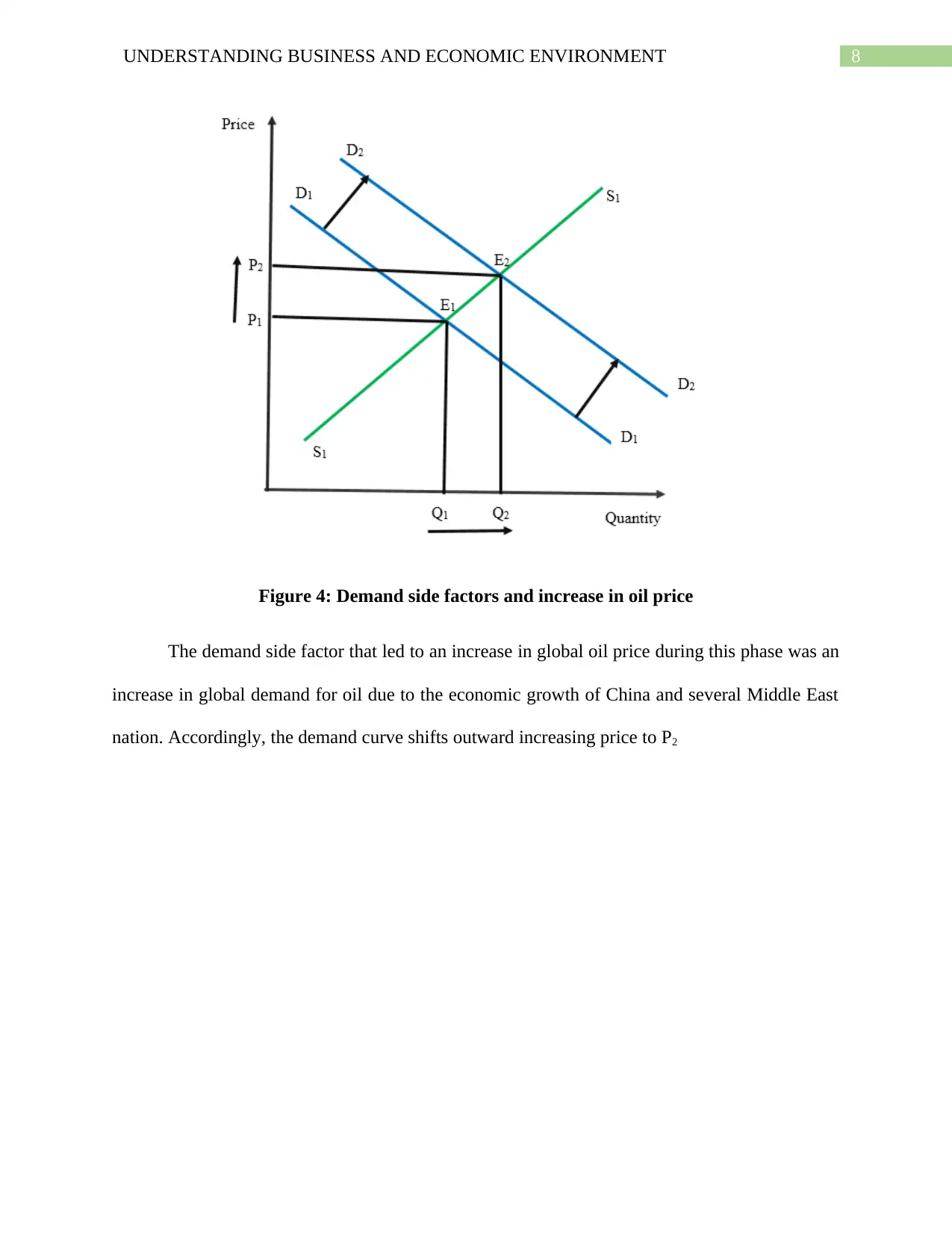
8UNDERSTANDING BUSINESS AND ECONOMIC ENVIRONMENT
Figure 4: Demand side factors and increase in oil price
The demand side factor that led to an increase in global oil price during this phase was an
increase in global demand for oil due to the economic growth of China and several Middle East
nation. Accordingly, the demand curve shifts outward increasing price to P2
Figure 4: Demand side factors and increase in oil price
The demand side factor that led to an increase in global oil price during this phase was an
increase in global demand for oil due to the economic growth of China and several Middle East
nation. Accordingly, the demand curve shifts outward increasing price to P2
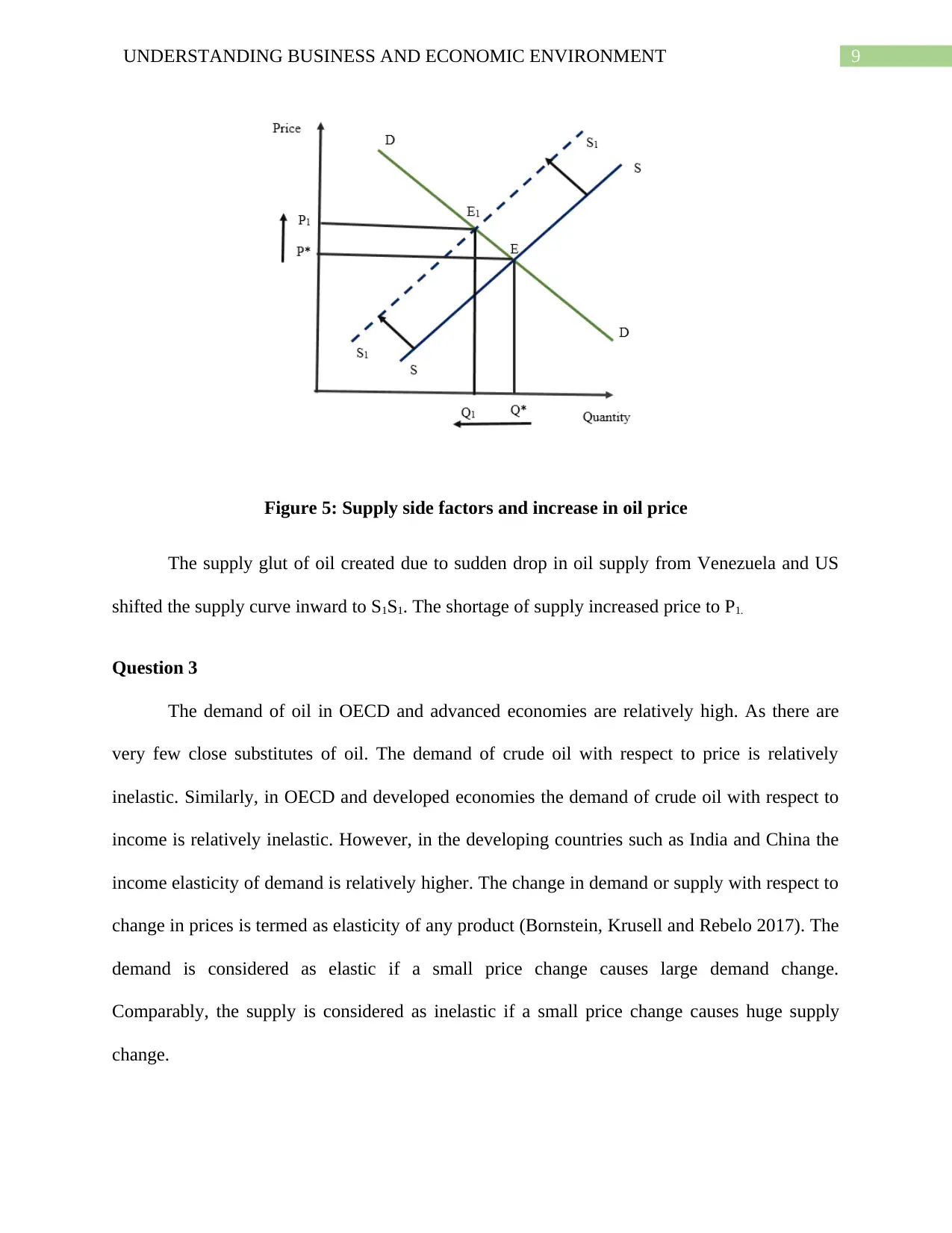
9UNDERSTANDING BUSINESS AND ECONOMIC ENVIRONMENT
Figure 5: Supply side factors and increase in oil price
The supply glut of oil created due to sudden drop in oil supply from Venezuela and US
shifted the supply curve inward to S1S1. The shortage of supply increased price to P1.
Question 3
The demand of oil in OECD and advanced economies are relatively high. As there are
very few close substitutes of oil. The demand of crude oil with respect to price is relatively
inelastic. Similarly, in OECD and developed economies the demand of crude oil with respect to
income is relatively inelastic. However, in the developing countries such as India and China the
income elasticity of demand is relatively higher. The change in demand or supply with respect to
change in prices is termed as elasticity of any product (Bornstein, Krusell and Rebelo 2017). The
demand is considered as elastic if a small price change causes large demand change.
Comparably, the supply is considered as inelastic if a small price change causes huge supply
change.
Figure 5: Supply side factors and increase in oil price
The supply glut of oil created due to sudden drop in oil supply from Venezuela and US
shifted the supply curve inward to S1S1. The shortage of supply increased price to P1.
Question 3
The demand of oil in OECD and advanced economies are relatively high. As there are
very few close substitutes of oil. The demand of crude oil with respect to price is relatively
inelastic. Similarly, in OECD and developed economies the demand of crude oil with respect to
income is relatively inelastic. However, in the developing countries such as India and China the
income elasticity of demand is relatively higher. The change in demand or supply with respect to
change in prices is termed as elasticity of any product (Bornstein, Krusell and Rebelo 2017). The
demand is considered as elastic if a small price change causes large demand change.
Comparably, the supply is considered as inelastic if a small price change causes huge supply
change.
Secure Best Marks with AI Grader
Need help grading? Try our AI Grader for instant feedback on your assignments.
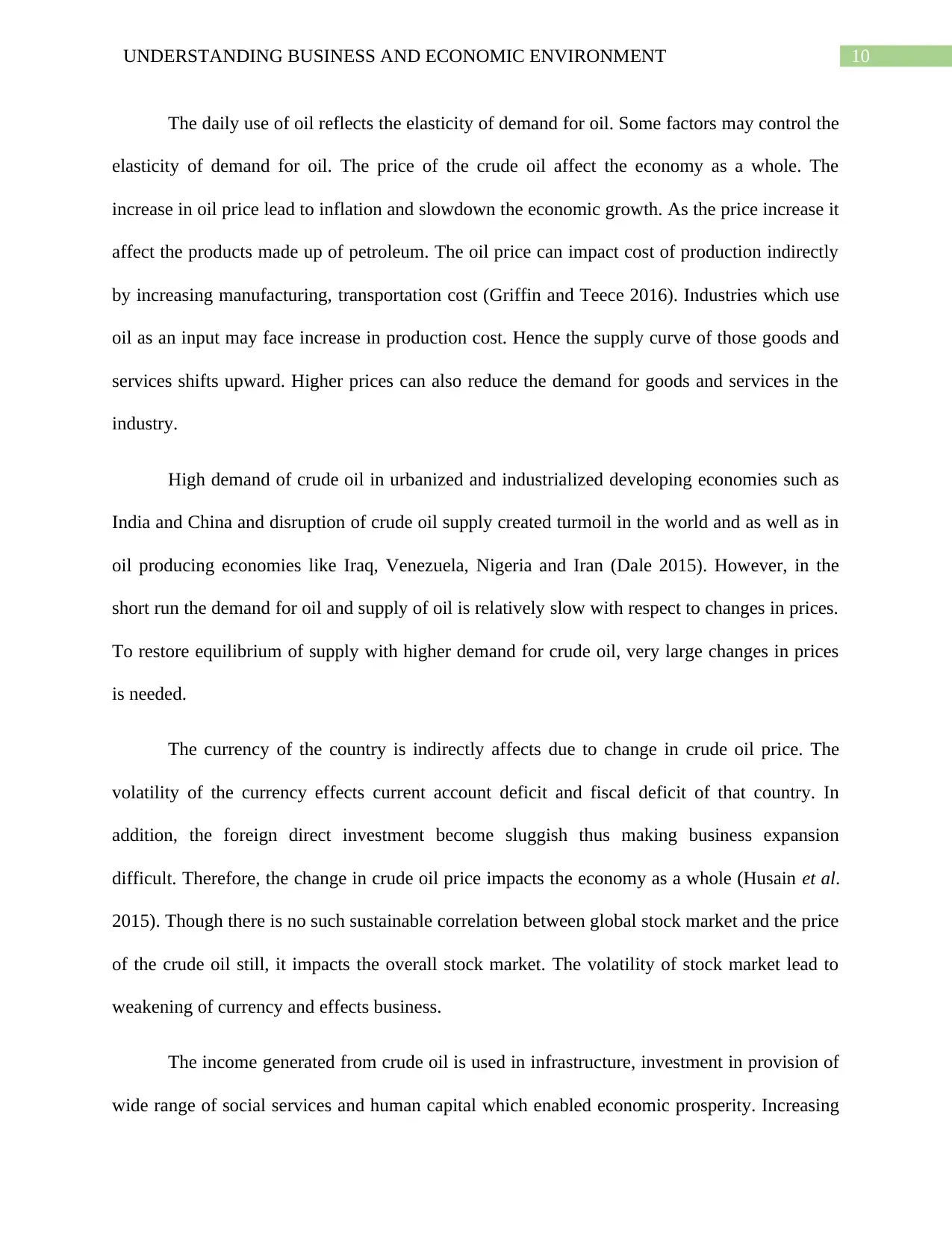
10UNDERSTANDING BUSINESS AND ECONOMIC ENVIRONMENT
The daily use of oil reflects the elasticity of demand for oil. Some factors may control the
elasticity of demand for oil. The price of the crude oil affect the economy as a whole. The
increase in oil price lead to inflation and slowdown the economic growth. As the price increase it
affect the products made up of petroleum. The oil price can impact cost of production indirectly
by increasing manufacturing, transportation cost (Griffin and Teece 2016). Industries which use
oil as an input may face increase in production cost. Hence the supply curve of those goods and
services shifts upward. Higher prices can also reduce the demand for goods and services in the
industry.
High demand of crude oil in urbanized and industrialized developing economies such as
India and China and disruption of crude oil supply created turmoil in the world and as well as in
oil producing economies like Iraq, Venezuela, Nigeria and Iran (Dale 2015). However, in the
short run the demand for oil and supply of oil is relatively slow with respect to changes in prices.
To restore equilibrium of supply with higher demand for crude oil, very large changes in prices
is needed.
The currency of the country is indirectly affects due to change in crude oil price. The
volatility of the currency effects current account deficit and fiscal deficit of that country. In
addition, the foreign direct investment become sluggish thus making business expansion
difficult. Therefore, the change in crude oil price impacts the economy as a whole (Husain et al.
2015). Though there is no such sustainable correlation between global stock market and the price
of the crude oil still, it impacts the overall stock market. The volatility of stock market lead to
weakening of currency and effects business.
The income generated from crude oil is used in infrastructure, investment in provision of
wide range of social services and human capital which enabled economic prosperity. Increasing
The daily use of oil reflects the elasticity of demand for oil. Some factors may control the
elasticity of demand for oil. The price of the crude oil affect the economy as a whole. The
increase in oil price lead to inflation and slowdown the economic growth. As the price increase it
affect the products made up of petroleum. The oil price can impact cost of production indirectly
by increasing manufacturing, transportation cost (Griffin and Teece 2016). Industries which use
oil as an input may face increase in production cost. Hence the supply curve of those goods and
services shifts upward. Higher prices can also reduce the demand for goods and services in the
industry.
High demand of crude oil in urbanized and industrialized developing economies such as
India and China and disruption of crude oil supply created turmoil in the world and as well as in
oil producing economies like Iraq, Venezuela, Nigeria and Iran (Dale 2015). However, in the
short run the demand for oil and supply of oil is relatively slow with respect to changes in prices.
To restore equilibrium of supply with higher demand for crude oil, very large changes in prices
is needed.
The currency of the country is indirectly affects due to change in crude oil price. The
volatility of the currency effects current account deficit and fiscal deficit of that country. In
addition, the foreign direct investment become sluggish thus making business expansion
difficult. Therefore, the change in crude oil price impacts the economy as a whole (Husain et al.
2015). Though there is no such sustainable correlation between global stock market and the price
of the crude oil still, it impacts the overall stock market. The volatility of stock market lead to
weakening of currency and effects business.
The income generated from crude oil is used in infrastructure, investment in provision of
wide range of social services and human capital which enabled economic prosperity. Increasing
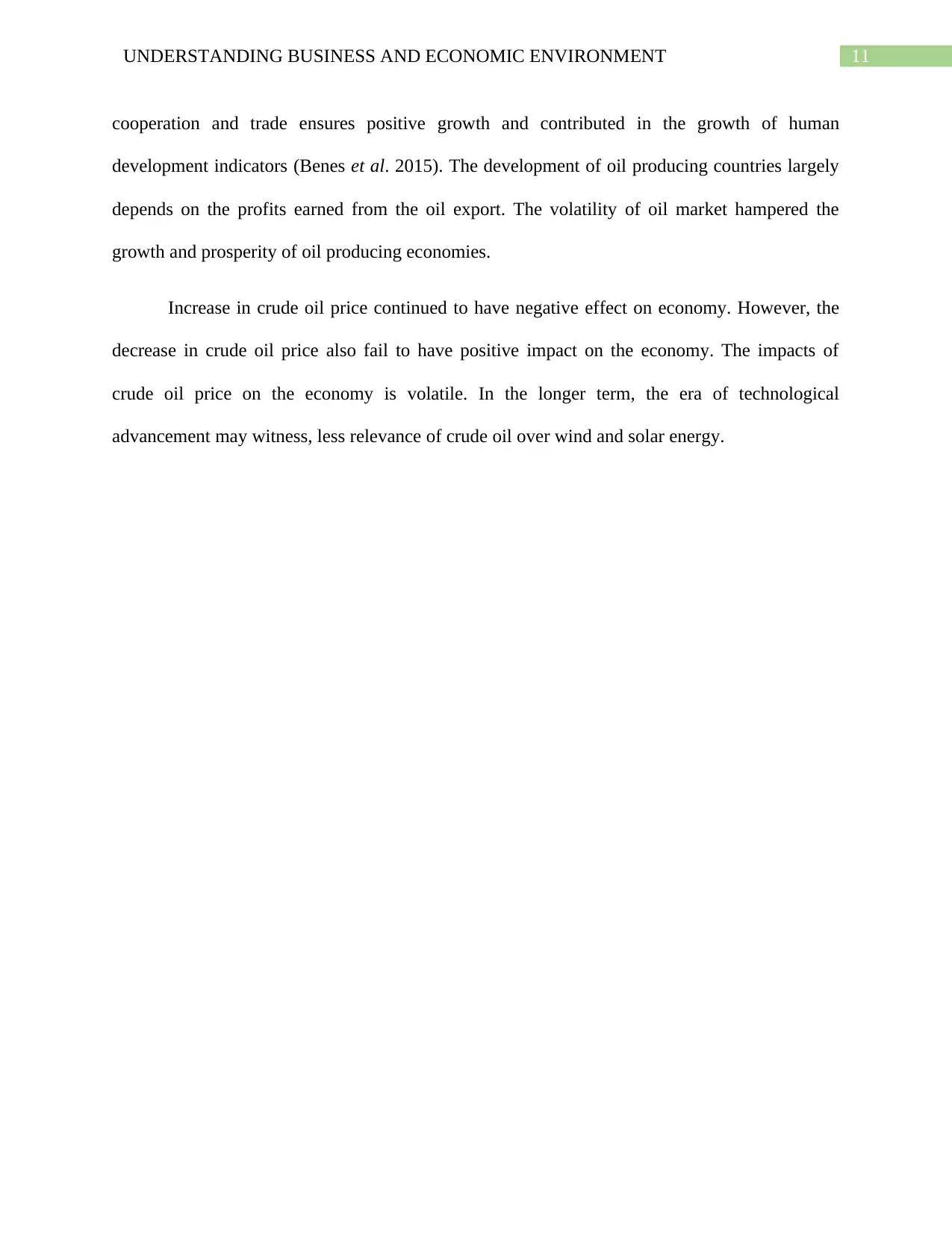
11UNDERSTANDING BUSINESS AND ECONOMIC ENVIRONMENT
cooperation and trade ensures positive growth and contributed in the growth of human
development indicators (Benes et al. 2015). The development of oil producing countries largely
depends on the profits earned from the oil export. The volatility of oil market hampered the
growth and prosperity of oil producing economies.
Increase in crude oil price continued to have negative effect on economy. However, the
decrease in crude oil price also fail to have positive impact on the economy. The impacts of
crude oil price on the economy is volatile. In the longer term, the era of technological
advancement may witness, less relevance of crude oil over wind and solar energy.
cooperation and trade ensures positive growth and contributed in the growth of human
development indicators (Benes et al. 2015). The development of oil producing countries largely
depends on the profits earned from the oil export. The volatility of oil market hampered the
growth and prosperity of oil producing economies.
Increase in crude oil price continued to have negative effect on economy. However, the
decrease in crude oil price also fail to have positive impact on the economy. The impacts of
crude oil price on the economy is volatile. In the longer term, the era of technological
advancement may witness, less relevance of crude oil over wind and solar energy.
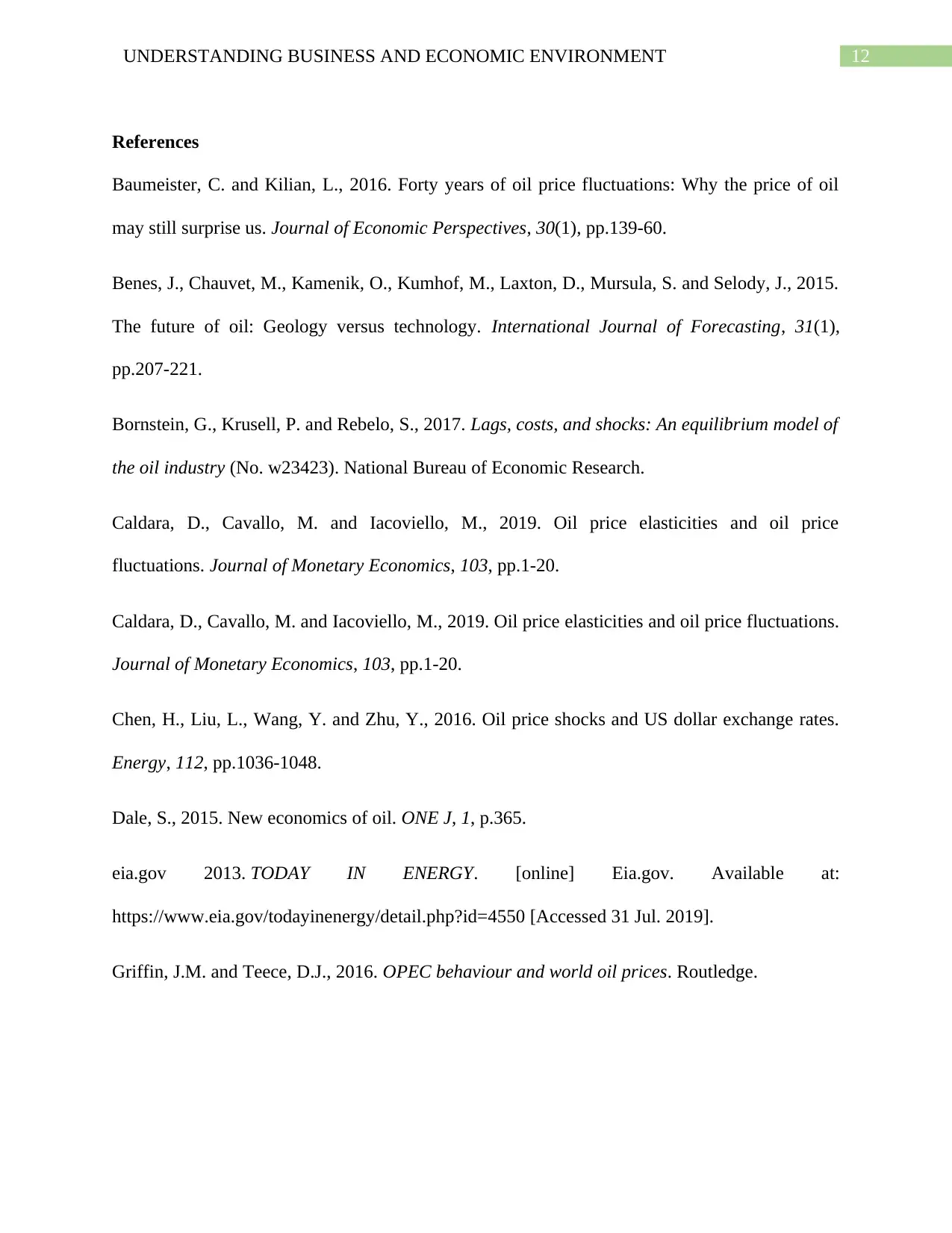
12UNDERSTANDING BUSINESS AND ECONOMIC ENVIRONMENT
References
Baumeister, C. and Kilian, L., 2016. Forty years of oil price fluctuations: Why the price of oil
may still surprise us. Journal of Economic Perspectives, 30(1), pp.139-60.
Benes, J., Chauvet, M., Kamenik, O., Kumhof, M., Laxton, D., Mursula, S. and Selody, J., 2015.
The future of oil: Geology versus technology. International Journal of Forecasting, 31(1),
pp.207-221.
Bornstein, G., Krusell, P. and Rebelo, S., 2017. Lags, costs, and shocks: An equilibrium model of
the oil industry (No. w23423). National Bureau of Economic Research.
Caldara, D., Cavallo, M. and Iacoviello, M., 2019. Oil price elasticities and oil price
fluctuations. Journal of Monetary Economics, 103, pp.1-20.
Caldara, D., Cavallo, M. and Iacoviello, M., 2019. Oil price elasticities and oil price fluctuations.
Journal of Monetary Economics, 103, pp.1-20.
Chen, H., Liu, L., Wang, Y. and Zhu, Y., 2016. Oil price shocks and US dollar exchange rates.
Energy, 112, pp.1036-1048.
Dale, S., 2015. New economics of oil. ONE J, 1, p.365.
eia.gov 2013. TODAY IN ENERGY. [online] Eia.gov. Available at:
https://www.eia.gov/todayinenergy/detail.php?id=4550 [Accessed 31 Jul. 2019].
Griffin, J.M. and Teece, D.J., 2016. OPEC behaviour and world oil prices. Routledge.
References
Baumeister, C. and Kilian, L., 2016. Forty years of oil price fluctuations: Why the price of oil
may still surprise us. Journal of Economic Perspectives, 30(1), pp.139-60.
Benes, J., Chauvet, M., Kamenik, O., Kumhof, M., Laxton, D., Mursula, S. and Selody, J., 2015.
The future of oil: Geology versus technology. International Journal of Forecasting, 31(1),
pp.207-221.
Bornstein, G., Krusell, P. and Rebelo, S., 2017. Lags, costs, and shocks: An equilibrium model of
the oil industry (No. w23423). National Bureau of Economic Research.
Caldara, D., Cavallo, M. and Iacoviello, M., 2019. Oil price elasticities and oil price
fluctuations. Journal of Monetary Economics, 103, pp.1-20.
Caldara, D., Cavallo, M. and Iacoviello, M., 2019. Oil price elasticities and oil price fluctuations.
Journal of Monetary Economics, 103, pp.1-20.
Chen, H., Liu, L., Wang, Y. and Zhu, Y., 2016. Oil price shocks and US dollar exchange rates.
Energy, 112, pp.1036-1048.
Dale, S., 2015. New economics of oil. ONE J, 1, p.365.
eia.gov 2013. TODAY IN ENERGY. [online] Eia.gov. Available at:
https://www.eia.gov/todayinenergy/detail.php?id=4550 [Accessed 31 Jul. 2019].
Griffin, J.M. and Teece, D.J., 2016. OPEC behaviour and world oil prices. Routledge.
Paraphrase This Document
Need a fresh take? Get an instant paraphrase of this document with our AI Paraphraser
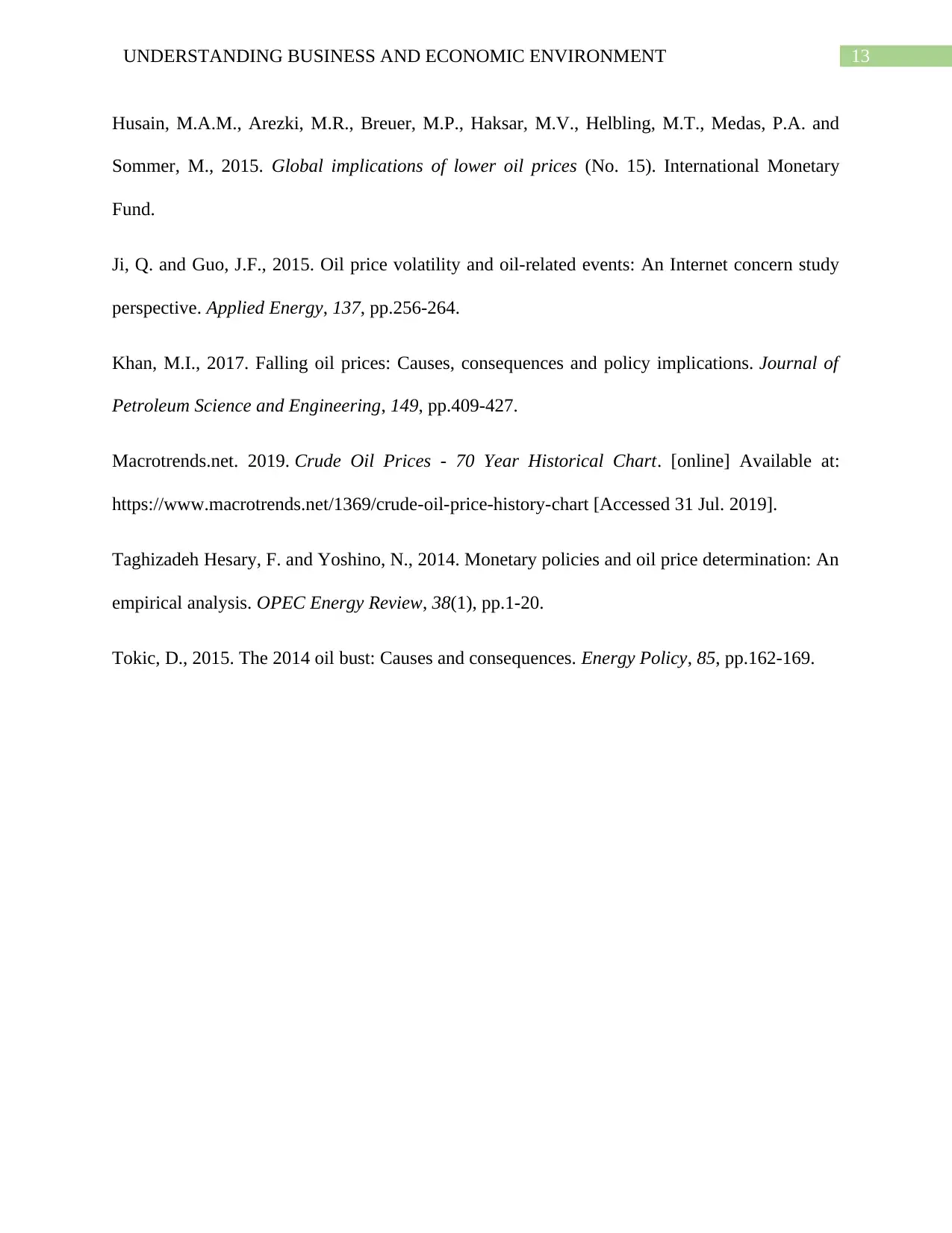
13UNDERSTANDING BUSINESS AND ECONOMIC ENVIRONMENT
Husain, M.A.M., Arezki, M.R., Breuer, M.P., Haksar, M.V., Helbling, M.T., Medas, P.A. and
Sommer, M., 2015. Global implications of lower oil prices (No. 15). International Monetary
Fund.
Ji, Q. and Guo, J.F., 2015. Oil price volatility and oil-related events: An Internet concern study
perspective. Applied Energy, 137, pp.256-264.
Khan, M.I., 2017. Falling oil prices: Causes, consequences and policy implications. Journal of
Petroleum Science and Engineering, 149, pp.409-427.
Macrotrends.net. 2019. Crude Oil Prices - 70 Year Historical Chart. [online] Available at:
https://www.macrotrends.net/1369/crude-oil-price-history-chart [Accessed 31 Jul. 2019].
Taghizadeh Hesary, F. and Yoshino, N., 2014. Monetary policies and oil price determination: An
empirical analysis. OPEC Energy Review, 38(1), pp.1-20.
Tokic, D., 2015. The 2014 oil bust: Causes and consequences. Energy Policy, 85, pp.162-169.
Husain, M.A.M., Arezki, M.R., Breuer, M.P., Haksar, M.V., Helbling, M.T., Medas, P.A. and
Sommer, M., 2015. Global implications of lower oil prices (No. 15). International Monetary
Fund.
Ji, Q. and Guo, J.F., 2015. Oil price volatility and oil-related events: An Internet concern study
perspective. Applied Energy, 137, pp.256-264.
Khan, M.I., 2017. Falling oil prices: Causes, consequences and policy implications. Journal of
Petroleum Science and Engineering, 149, pp.409-427.
Macrotrends.net. 2019. Crude Oil Prices - 70 Year Historical Chart. [online] Available at:
https://www.macrotrends.net/1369/crude-oil-price-history-chart [Accessed 31 Jul. 2019].
Taghizadeh Hesary, F. and Yoshino, N., 2014. Monetary policies and oil price determination: An
empirical analysis. OPEC Energy Review, 38(1), pp.1-20.
Tokic, D., 2015. The 2014 oil bust: Causes and consequences. Energy Policy, 85, pp.162-169.
1 out of 14
Related Documents
Your All-in-One AI-Powered Toolkit for Academic Success.
+13062052269
info@desklib.com
Available 24*7 on WhatsApp / Email
![[object Object]](/_next/static/media/star-bottom.7253800d.svg)
Unlock your academic potential
© 2024 | Zucol Services PVT LTD | All rights reserved.





